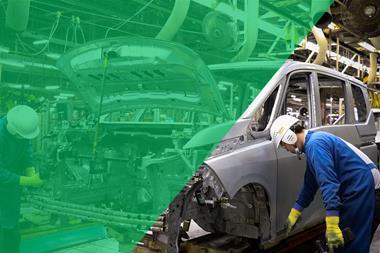
Mark Venables reveals how continued innovation in the manufacture, properties and application of new steel grades is evolving vehicle structures
The steel used in automotive production today bears little resemblance to that used 20 or even 10 years ago. This ubiquitous material has been continually re-invented, engineering new grades and gauges. The need to reduce new vehicle emissions is the main driver for this, with target levels for 2025 to be as low as 70g/km. To achieve that target, vehicle weight must be significantly reduced and
As it comprises around 60% of a car’s weight, the focus is very much on steel and this material offers the best compromise between cost and performance.
Steelmakers have reacted by developing ever lighter, yet stronger steels, dubbed advanced high-strength Steel (AHSS) or ultra-high-strength steel (UHSS) depending on the manufacturer. There are Dual Phase (DP) steels and TRIP (transformation induced plasticity) steels. Numerous grades have transcended the 1000MPa barrier and there is even talk of a martensitic grade at 1700MPa.
Aside from the steel itself, the various coatings and hardening processes have evolved. For coatings, hot dip galvanisation and electro galvanisation remain the preferred solutions for automotive steels.
Hot press forming is increasingly being used by automotive manufacturers and their suppliers to manufacture complex body parts capable of withstanding impacts.
There have also been advances in the processes used to make the steel itself and the associated car parts. Tailored blanks have been around for some time but improvements in the manufacturing and welding process are opening the door to new applications. These blanks are sheets of steel that combine several grades in various thicknesses and with different coatings, welded together in order to place the best material at the best place, in the right thickness, to provide a tailor made solution after stamping. They have been around for a while but innovative laser welding technology is now allowing hot stamping of these blanks, thereby increasing their use.
Press hardening technology makes the material three times as hard as the original sheet, which enables production of very high-strength and light-weight parts.
One of the most innovative carmakers, VW, is actually using greater amounts of steel now. “VW is using high-strength steel in increasing amounts,” says Armin Plath, VW’s head of material research and manufacturing. “It is a cost-effective way of reducing weight. Using new innovations in steel engineering it is possible to reduce weight without the use of more costly materials such as aluminium and carbon fibre.”
This technology is already appearing on roads around the globe. The 2013 Ford Fusion features comprehensive use of boron-alloyed HSS and incorporates a hydroformed B-pillar and A-pillar roof rail.













































